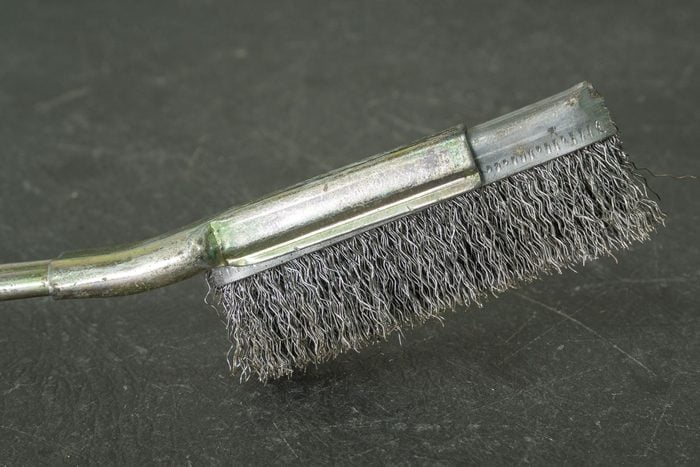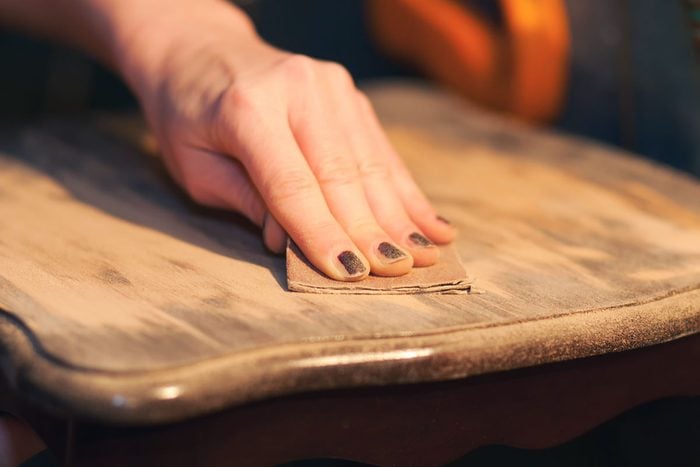
Use a Pressure Washer
For overspray on a concrete garage floor or driveway, Sutter says to try a pressure washer. Depending on the type of paint and the time it’s been on the concrete, this method can work with or without harsh solvents.
“Water-based spray paints are easier to remove because they can often be dissolved or softened with water,” Sutter says, “making the cleanup process less demanding.”
Check the paint label. If your paint overspray is water-based, try using just water, or a soap and water mixture. If it just happened, you’re likely to dislodge it. “Oil-based paints, on the other hand, may require stronger solvents for removal,” Sutter says.

Scrub With a Stiff Brush
If you don’t have a pressure washer, try a stiff-bristle brush on your concrete garage floor or wall. Pick up a graffiti remover solution at a home improvement center and start scrubbing.
“The time spray paint has been on a surface can affect cleanup,” Sutter says. “Fresh overspray is generally easier to remove compared to graffiti that has been there for years, as it may have adhered more firmly to the surface.”

Sand It Out
For overspray on wood surfaces, you can try sanding it off. But, Sutter says, “Be careful with wood, as aggressive methods may damage the surface.”
Start with a fine-grit sandpaper, then move to coarser grit if the paint is thick and doesn’t budge. Go slowly and check the wood frequently. Sandpaper can quickly remove the top surface of wood, including finishes, like stain and varnish.
Power washers also work on wood, but the same advice for sandpaper applies: Use caution to avoid damage.

Use Automotive Clay
For overspray on a car, try what car detailers always have on hand: automotive clay bars, aka detailing clay or just clay bars.
Clay-barring removes tree sap, tar and other contaminants from automotive paint by transferring the stuck-on goo from the paint finish to a malleable clay bar. If you’ve ever used Silly Putty to transfer newsprint or pencil marks, you get the idea. If the paint is stubborn, Sutter says a pro auto detailer may have better luck.

Clean With Glass Cleaner
Did overspray drift onto your big bay window? “In some cases, glass cleaner with ammonia can work to remove the paint,” Sutter says. It’s worth a shot, especially if the paint is freshly sprayed.
Many commercial glass cleaners contain ammonia. It’s a powerful solvent that evaporates quickly for a streak-free shine. Or you can make your own ammonia-based glass cleaner by adding a half-cup ammonia to a gallon of water.
If that doesn’t work, try the next tip.

Scrape With a Razor Blade
Razor blades are amazing little tools that can definitely remove paint from windows. They’re also really sharp and can easily scratch your window (and cut your fingers).
Wet the window and always use a new blade. Apply even pressure at a slight angle and gently scrape off the paint. Don’t push down on the corners to avoid scratching the window. For more control, razor blade scrapers have molded handles for ease and safety.

Automotive Paint Thinner
If the clay bar didn’t work, or you happen to have automotive paint thinner in your garage, Sutter says this can work on overspray. But be careful. “Automotive paint can be sensitive,” he says.
Paint thinners, used correctly, can remove overspray without damaging the actual paint job. But your car is a valuable asset, so take it to a professional if you’re unsure, or if the job is sizable.

Use Acetone or Rubbing Alcohol
Traditional nail polish remover, aka acetone, can remove spray paint on glass, certain plastics and vinyl, Sutter says.
Acetone is a common ingredient in lacquer thinner, so Sutter says to use caution with plastics and vinyl. Test a small area to make sure it holds up. Rubbing alcohol is another option for plastics and vinyl.

Consider Repainting
If you’ve oversprayed onto your painted drywall, I’m sorry, you’re probably out of luck. It’s difficult to remove spray paint from your living room wall. That’s another reason why you should be in your open garage!
“You can try using paint strippers, but be cautious as they may damage the wall paint,” Sutter says. Test a small area to check the reaction. “For painted walls, consider repainting instead,” he says.

What Doesn’t Work?
The internet is filled with bad advice. If you need to remove spray paint, avoid these common misconceptions. “While these household items may have some cleaning properties,” Sutter says, “they are generally ineffective for removing spray paint from various surfaces.”
- Toothpaste;
- Vinegar;
- Baking soda.
Another no-no is steel wool. “[U]sing abrasive methods like steel wool can cause more harm than good,” Sutter says, “as it can scratch or damage the surface.”

